Is Managing Diversity a Challenge for UK HR Practitioners?
VerifiedAdded on 2020/07/22
|40
|8648
|91
Report
AI Summary
This report investigates the challenges of managing diversity in the context of 21st-century UK HR practices, focusing on its impact on employee engagement. The report begins with an abstract and includes a literature review exploring employee engagement, its benefits, and related theories, as well as the concept of diversity in the workplace and its various dimensions. The research delves into the rationale behind the topic, setting out the aims and objectives of the study. The report presents data analysis and interpretation, supported by primary research and surveys, to assess the relationship between diversity and employee engagement. It provides a comprehensive overview of the challenges HR practitioners face in diverse environments, offering recommendations to overcome conflicts and enhance employee engagement within the UK context. The conclusion summarizes the key findings and offers insights for effective diversity management strategies.

Paraphrase This Document
Need a fresh take? Get an instant paraphrase of this document with our AI Paraphraser
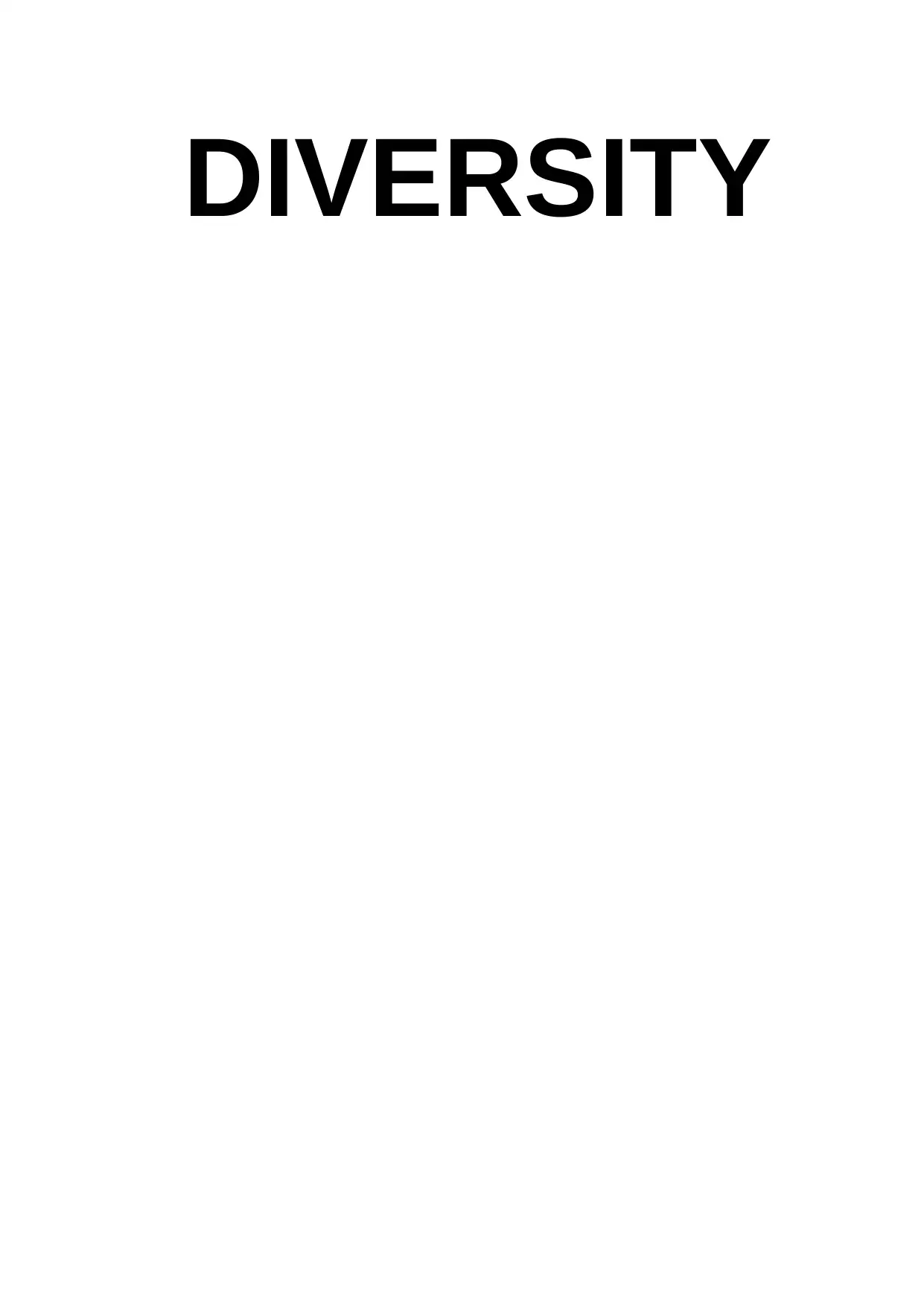
DIVERSITY
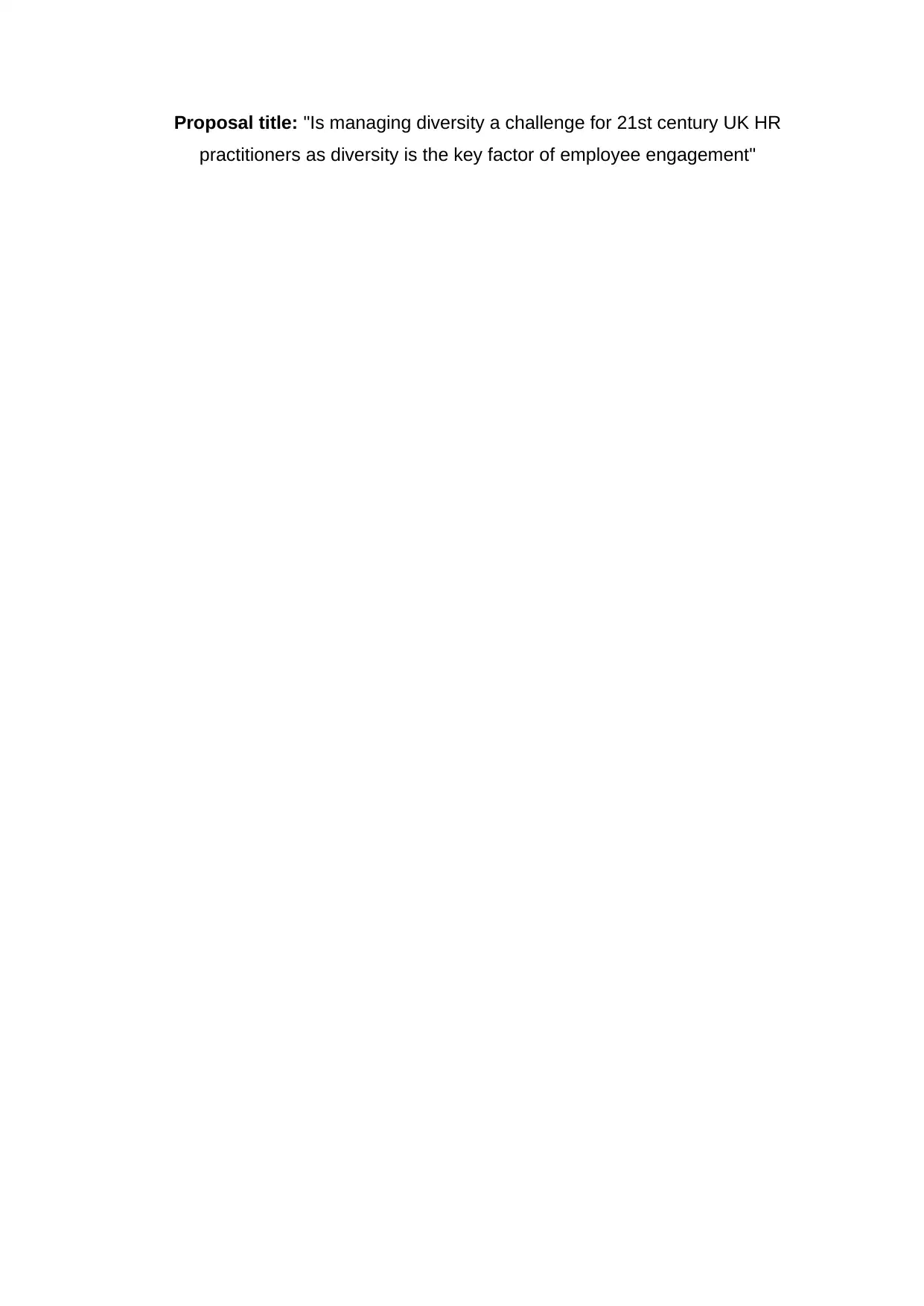
Proposal title: "Is managing diversity a challenge for 21st century UK HR
practitioners as diversity is the key factor of employee engagement"
practitioners as diversity is the key factor of employee engagement"
⊘ This is a preview!⊘
Do you want full access?
Subscribe today to unlock all pages.

Trusted by 1+ million students worldwide
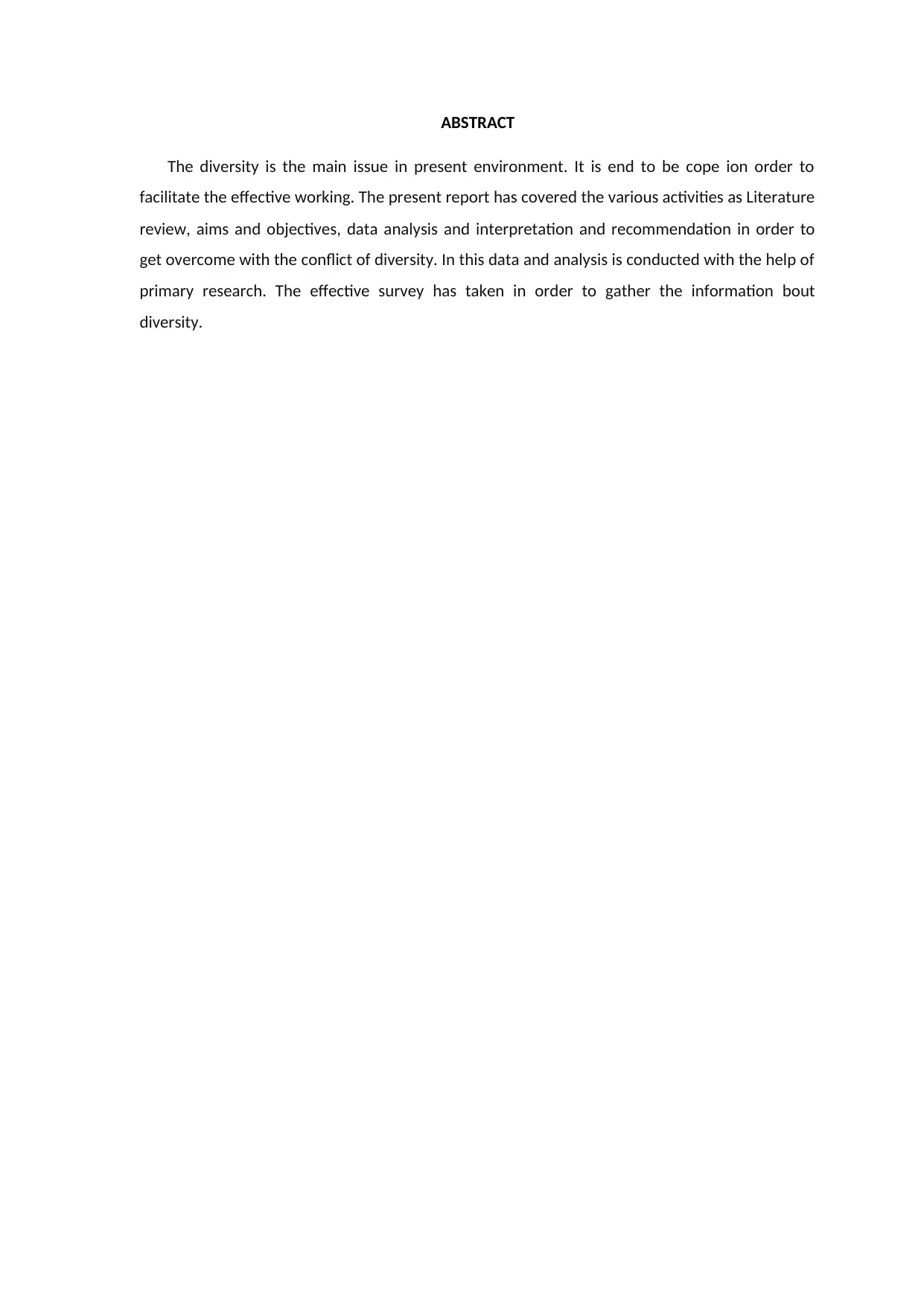
ABSTRACT
The diversity is the main issue in present environment. It is end to be cope ion order to
facilitate the effective working. The present report has covered the various activities as Literature
review, aims and objectives, data analysis and interpretation and recommendation in order to
get overcome with the conflict of diversity. In this data and analysis is conducted with the help of
primary research. The effective survey has taken in order to gather the information bout
diversity.
The diversity is the main issue in present environment. It is end to be cope ion order to
facilitate the effective working. The present report has covered the various activities as Literature
review, aims and objectives, data analysis and interpretation and recommendation in order to
get overcome with the conflict of diversity. In this data and analysis is conducted with the help of
primary research. The effective survey has taken in order to gather the information bout
diversity.
Paraphrase This Document
Need a fresh take? Get an instant paraphrase of this document with our AI Paraphraser
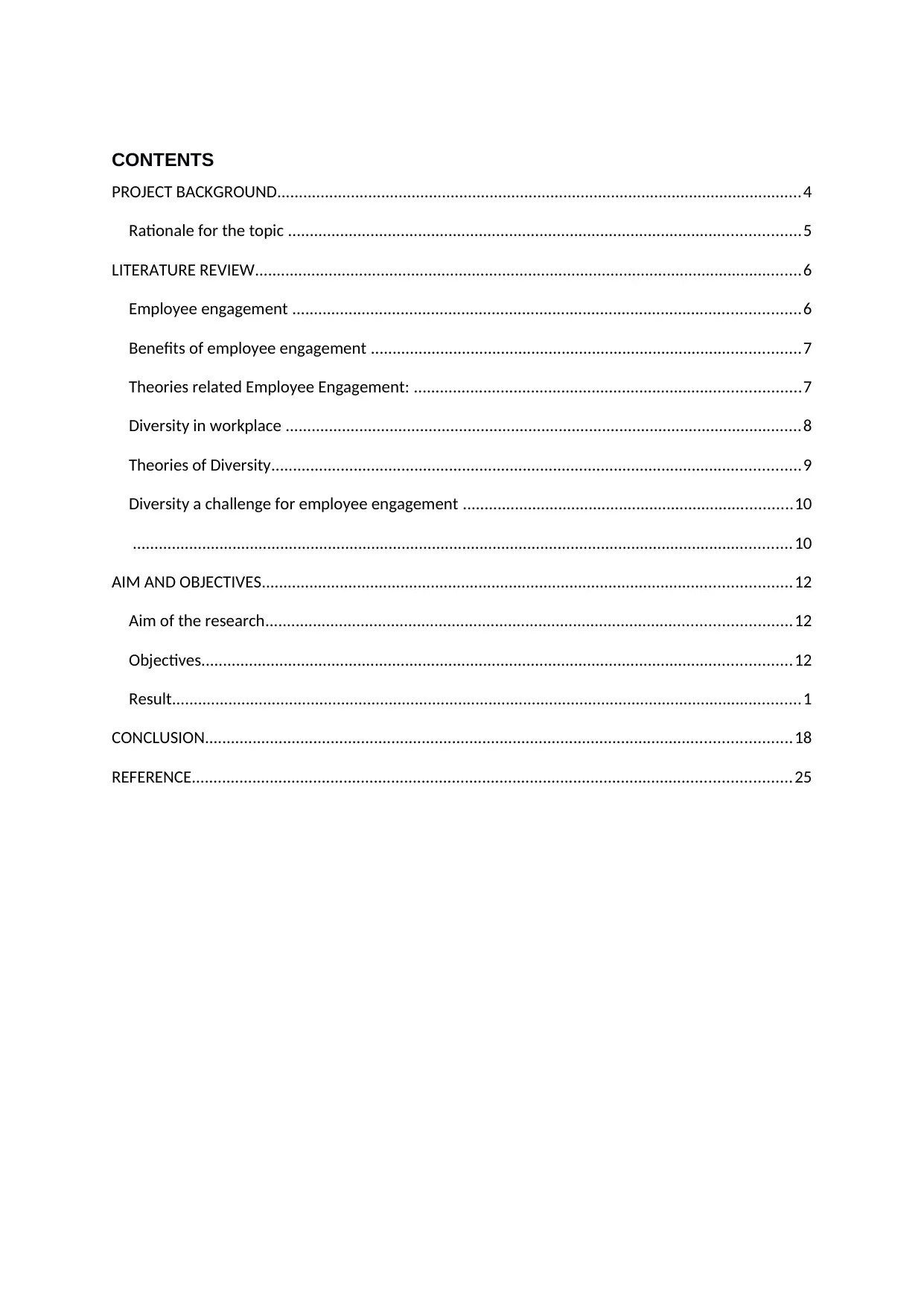
CONTENTS
PROJECT BACKGROUND.........................................................................................................................4
Rationale for the topic ......................................................................................................................5
LITERATURE REVIEW..............................................................................................................................6
Employee engagement .....................................................................................................................6
Benefits of employee engagement ...................................................................................................7
Theories related Employee Engagement: .........................................................................................7
Diversity in workplace .......................................................................................................................8
Theories of Diversity..........................................................................................................................9
Diversity a challenge for employee engagement ............................................................................10
........................................................................................................................................................10
AIM AND OBJECTIVES..........................................................................................................................12
Aim of the research.........................................................................................................................12
Objectives........................................................................................................................................12
Result.................................................................................................................................................1
CONCLUSION.......................................................................................................................................18
REFERENCE..........................................................................................................................................25
PROJECT BACKGROUND.........................................................................................................................4
Rationale for the topic ......................................................................................................................5
LITERATURE REVIEW..............................................................................................................................6
Employee engagement .....................................................................................................................6
Benefits of employee engagement ...................................................................................................7
Theories related Employee Engagement: .........................................................................................7
Diversity in workplace .......................................................................................................................8
Theories of Diversity..........................................................................................................................9
Diversity a challenge for employee engagement ............................................................................10
........................................................................................................................................................10
AIM AND OBJECTIVES..........................................................................................................................12
Aim of the research.........................................................................................................................12
Objectives........................................................................................................................................12
Result.................................................................................................................................................1
CONCLUSION.......................................................................................................................................18
REFERENCE..........................................................................................................................................25
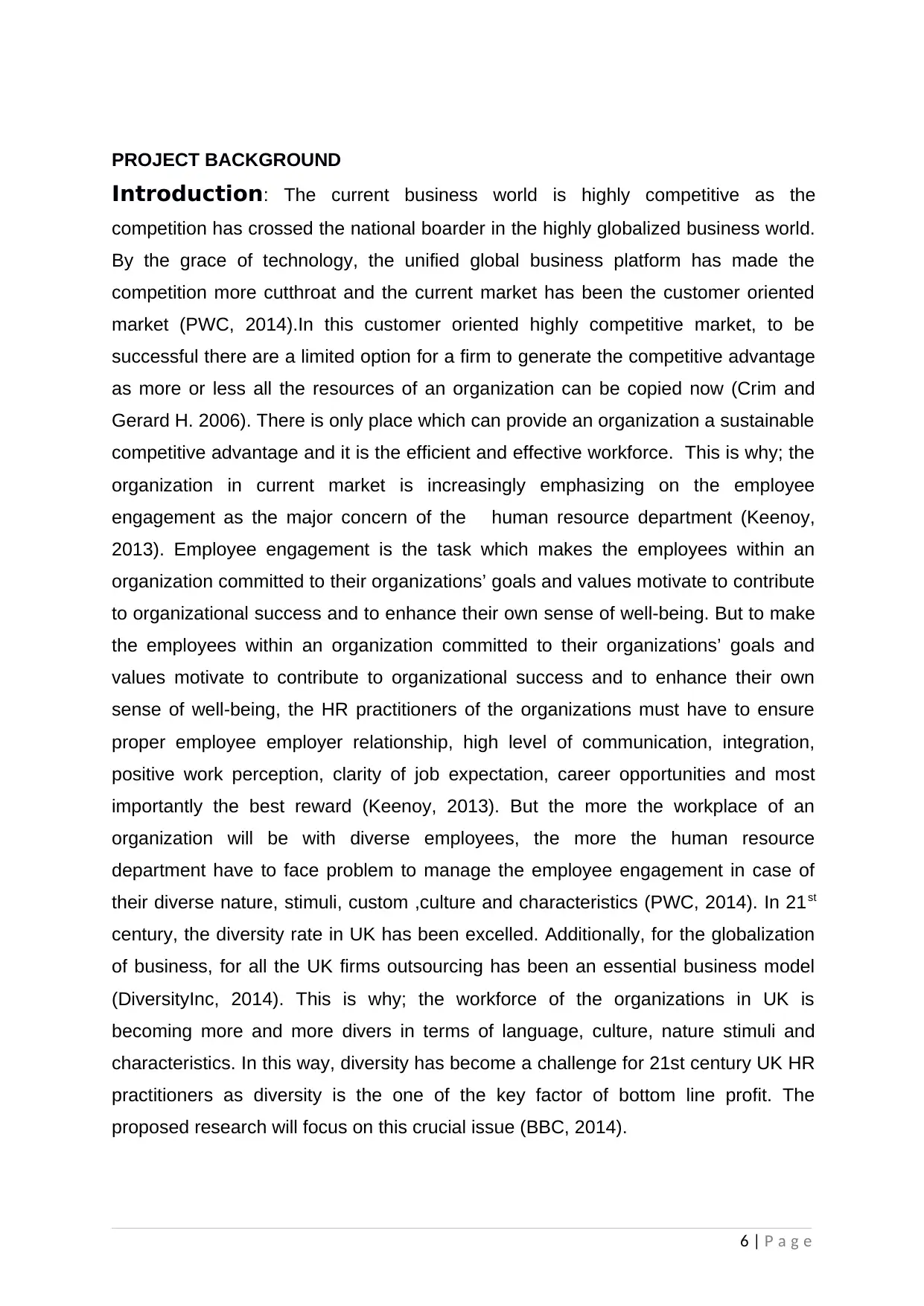
PROJECT BACKGROUND
Introduction: The current business world is highly competitive as the
competition has crossed the national boarder in the highly globalized business world.
By the grace of technology, the unified global business platform has made the
competition more cutthroat and the current market has been the customer oriented
market (PWC, 2014).In this customer oriented highly competitive market, to be
successful there are a limited option for a firm to generate the competitive advantage
as more or less all the resources of an organization can be copied now (Crim and
Gerard H. 2006). There is only place which can provide an organization a sustainable
competitive advantage and it is the efficient and effective workforce. This is why; the
organization in current market is increasingly emphasizing on the employee
engagement as the major concern of the human resource department (Keenoy,
2013). Employee engagement is the task which makes the employees within an
organization committed to their organizations’ goals and values motivate to contribute
to organizational success and to enhance their own sense of well-being. But to make
the employees within an organization committed to their organizations’ goals and
values motivate to contribute to organizational success and to enhance their own
sense of well-being, the HR practitioners of the organizations must have to ensure
proper employee employer relationship, high level of communication, integration,
positive work perception, clarity of job expectation, career opportunities and most
importantly the best reward (Keenoy, 2013). But the more the workplace of an
organization will be with diverse employees, the more the human resource
department have to face problem to manage the employee engagement in case of
their diverse nature, stimuli, custom ,culture and characteristics (PWC, 2014). In 21st
century, the diversity rate in UK has been excelled. Additionally, for the globalization
of business, for all the UK firms outsourcing has been an essential business model
(DiversityInc, 2014). This is why; the workforce of the organizations in UK is
becoming more and more divers in terms of language, culture, nature stimuli and
characteristics. In this way, diversity has become a challenge for 21st century UK HR
practitioners as diversity is the one of the key factor of bottom line profit. The
proposed research will focus on this crucial issue (BBC, 2014).
6 | P a g e
Introduction: The current business world is highly competitive as the
competition has crossed the national boarder in the highly globalized business world.
By the grace of technology, the unified global business platform has made the
competition more cutthroat and the current market has been the customer oriented
market (PWC, 2014).In this customer oriented highly competitive market, to be
successful there are a limited option for a firm to generate the competitive advantage
as more or less all the resources of an organization can be copied now (Crim and
Gerard H. 2006). There is only place which can provide an organization a sustainable
competitive advantage and it is the efficient and effective workforce. This is why; the
organization in current market is increasingly emphasizing on the employee
engagement as the major concern of the human resource department (Keenoy,
2013). Employee engagement is the task which makes the employees within an
organization committed to their organizations’ goals and values motivate to contribute
to organizational success and to enhance their own sense of well-being. But to make
the employees within an organization committed to their organizations’ goals and
values motivate to contribute to organizational success and to enhance their own
sense of well-being, the HR practitioners of the organizations must have to ensure
proper employee employer relationship, high level of communication, integration,
positive work perception, clarity of job expectation, career opportunities and most
importantly the best reward (Keenoy, 2013). But the more the workplace of an
organization will be with diverse employees, the more the human resource
department have to face problem to manage the employee engagement in case of
their diverse nature, stimuli, custom ,culture and characteristics (PWC, 2014). In 21st
century, the diversity rate in UK has been excelled. Additionally, for the globalization
of business, for all the UK firms outsourcing has been an essential business model
(DiversityInc, 2014). This is why; the workforce of the organizations in UK is
becoming more and more divers in terms of language, culture, nature stimuli and
characteristics. In this way, diversity has become a challenge for 21st century UK HR
practitioners as diversity is the one of the key factor of bottom line profit. The
proposed research will focus on this crucial issue (BBC, 2014).
6 | P a g e
⊘ This is a preview!⊘
Do you want full access?
Subscribe today to unlock all pages.

Trusted by 1+ million students worldwide
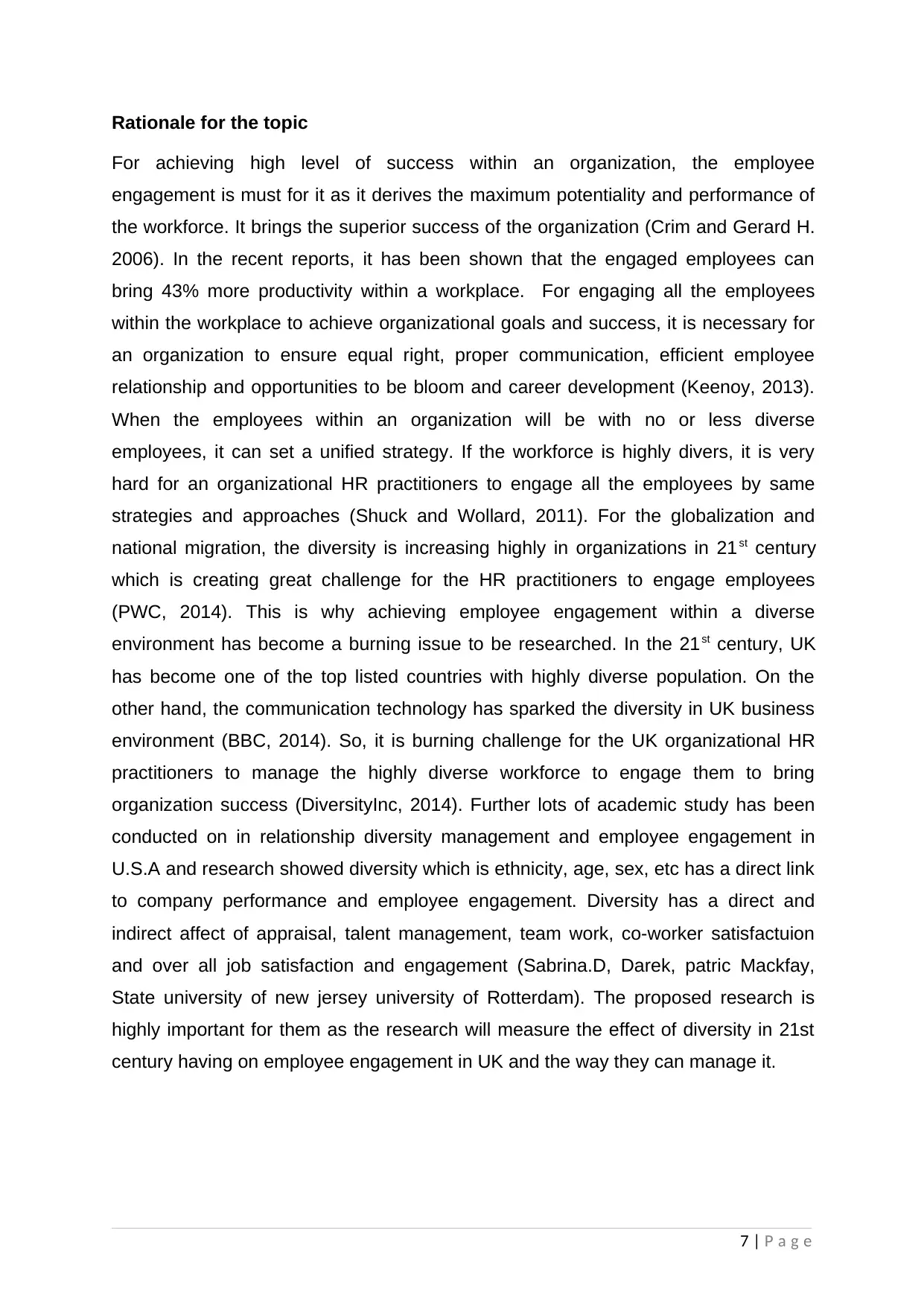
Rationale for the topic
For achieving high level of success within an organization, the employee
engagement is must for it as it derives the maximum potentiality and performance of
the workforce. It brings the superior success of the organization (Crim and Gerard H.
2006). In the recent reports, it has been shown that the engaged employees can
bring 43% more productivity within a workplace. For engaging all the employees
within the workplace to achieve organizational goals and success, it is necessary for
an organization to ensure equal right, proper communication, efficient employee
relationship and opportunities to be bloom and career development (Keenoy, 2013).
When the employees within an organization will be with no or less diverse
employees, it can set a unified strategy. If the workforce is highly divers, it is very
hard for an organizational HR practitioners to engage all the employees by same
strategies and approaches (Shuck and Wollard, 2011). For the globalization and
national migration, the diversity is increasing highly in organizations in 21st century
which is creating great challenge for the HR practitioners to engage employees
(PWC, 2014). This is why achieving employee engagement within a diverse
environment has become a burning issue to be researched. In the 21st century, UK
has become one of the top listed countries with highly diverse population. On the
other hand, the communication technology has sparked the diversity in UK business
environment (BBC, 2014). So, it is burning challenge for the UK organizational HR
practitioners to manage the highly diverse workforce to engage them to bring
organization success (DiversityInc, 2014). Further lots of academic study has been
conducted on in relationship diversity management and employee engagement in
U.S.A and research showed diversity which is ethnicity, age, sex, etc has a direct link
to company performance and employee engagement. Diversity has a direct and
indirect affect of appraisal, talent management, team work, co-worker satisfactuion
and over all job satisfaction and engagement (Sabrina.D, Darek, patric Mackfay,
State university of new jersey university of Rotterdam). The proposed research is
highly important for them as the research will measure the effect of diversity in 21st
century having on employee engagement in UK and the way they can manage it.
7 | P a g e
For achieving high level of success within an organization, the employee
engagement is must for it as it derives the maximum potentiality and performance of
the workforce. It brings the superior success of the organization (Crim and Gerard H.
2006). In the recent reports, it has been shown that the engaged employees can
bring 43% more productivity within a workplace. For engaging all the employees
within the workplace to achieve organizational goals and success, it is necessary for
an organization to ensure equal right, proper communication, efficient employee
relationship and opportunities to be bloom and career development (Keenoy, 2013).
When the employees within an organization will be with no or less diverse
employees, it can set a unified strategy. If the workforce is highly divers, it is very
hard for an organizational HR practitioners to engage all the employees by same
strategies and approaches (Shuck and Wollard, 2011). For the globalization and
national migration, the diversity is increasing highly in organizations in 21st century
which is creating great challenge for the HR practitioners to engage employees
(PWC, 2014). This is why achieving employee engagement within a diverse
environment has become a burning issue to be researched. In the 21st century, UK
has become one of the top listed countries with highly diverse population. On the
other hand, the communication technology has sparked the diversity in UK business
environment (BBC, 2014). So, it is burning challenge for the UK organizational HR
practitioners to manage the highly diverse workforce to engage them to bring
organization success (DiversityInc, 2014). Further lots of academic study has been
conducted on in relationship diversity management and employee engagement in
U.S.A and research showed diversity which is ethnicity, age, sex, etc has a direct link
to company performance and employee engagement. Diversity has a direct and
indirect affect of appraisal, talent management, team work, co-worker satisfactuion
and over all job satisfaction and engagement (Sabrina.D, Darek, patric Mackfay,
State university of new jersey university of Rotterdam). The proposed research is
highly important for them as the research will measure the effect of diversity in 21st
century having on employee engagement in UK and the way they can manage it.
7 | P a g e
Paraphrase This Document
Need a fresh take? Get an instant paraphrase of this document with our AI Paraphraser
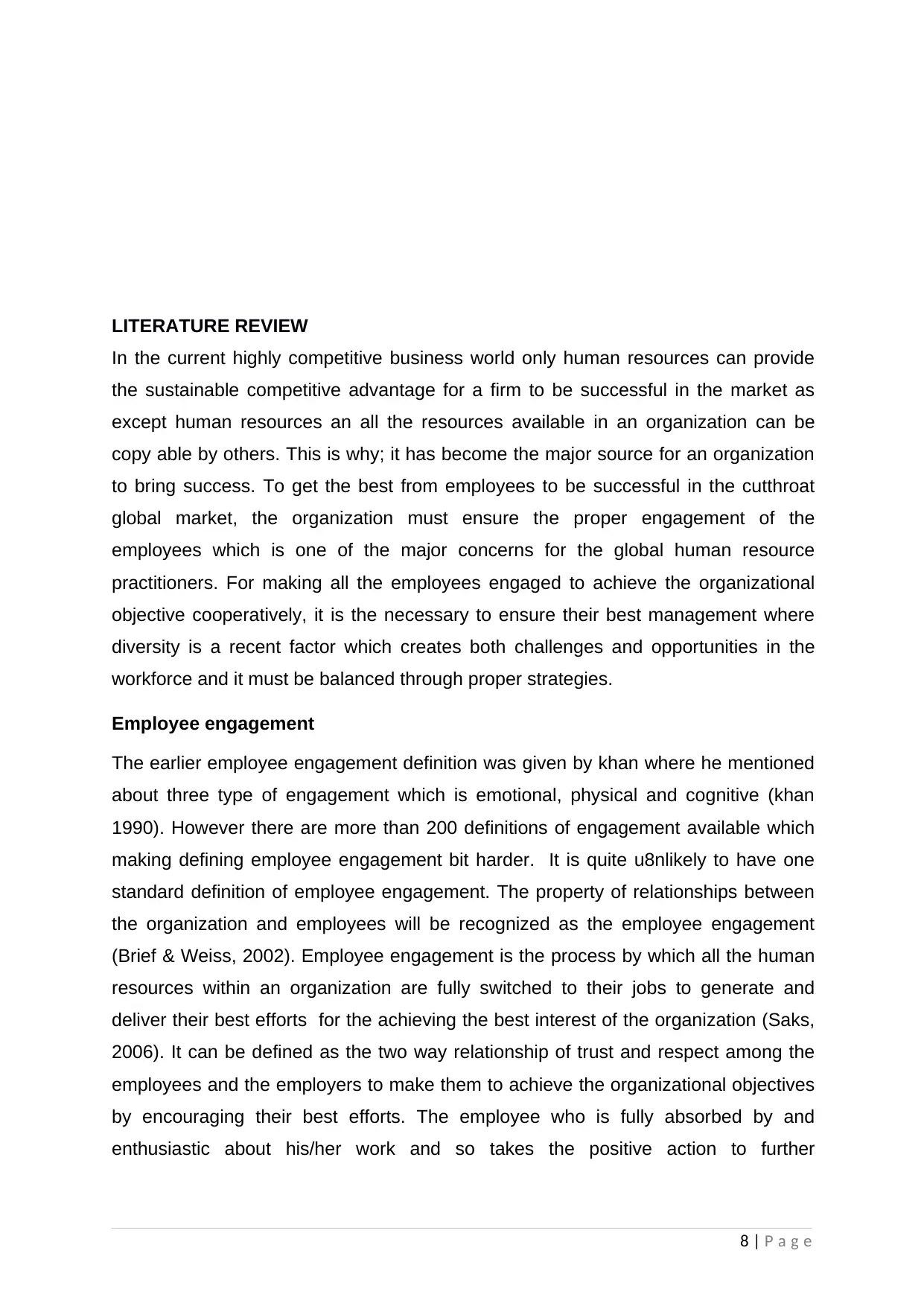
LITERATURE REVIEW
In the current highly competitive business world only human resources can provide
the sustainable competitive advantage for a firm to be successful in the market as
except human resources an all the resources available in an organization can be
copy able by others. This is why; it has become the major source for an organization
to bring success. To get the best from employees to be successful in the cutthroat
global market, the organization must ensure the proper engagement of the
employees which is one of the major concerns for the global human resource
practitioners. For making all the employees engaged to achieve the organizational
objective cooperatively, it is the necessary to ensure their best management where
diversity is a recent factor which creates both challenges and opportunities in the
workforce and it must be balanced through proper strategies.
Employee engagement
The earlier employee engagement definition was given by khan where he mentioned
about three type of engagement which is emotional, physical and cognitive (khan
1990). However there are more than 200 definitions of engagement available which
making defining employee engagement bit harder. It is quite u8nlikely to have one
standard definition of employee engagement. The property of relationships between
the organization and employees will be recognized as the employee engagement
(Brief & Weiss, 2002). Employee engagement is the process by which all the human
resources within an organization are fully switched to their jobs to generate and
deliver their best efforts for the achieving the best interest of the organization (Saks,
2006). It can be defined as the two way relationship of trust and respect among the
employees and the employers to make them to achieve the organizational objectives
by encouraging their best efforts. The employee who is fully absorbed by and
enthusiastic about his/her work and so takes the positive action to further
8 | P a g e
In the current highly competitive business world only human resources can provide
the sustainable competitive advantage for a firm to be successful in the market as
except human resources an all the resources available in an organization can be
copy able by others. This is why; it has become the major source for an organization
to bring success. To get the best from employees to be successful in the cutthroat
global market, the organization must ensure the proper engagement of the
employees which is one of the major concerns for the global human resource
practitioners. For making all the employees engaged to achieve the organizational
objective cooperatively, it is the necessary to ensure their best management where
diversity is a recent factor which creates both challenges and opportunities in the
workforce and it must be balanced through proper strategies.
Employee engagement
The earlier employee engagement definition was given by khan where he mentioned
about three type of engagement which is emotional, physical and cognitive (khan
1990). However there are more than 200 definitions of engagement available which
making defining employee engagement bit harder. It is quite u8nlikely to have one
standard definition of employee engagement. The property of relationships between
the organization and employees will be recognized as the employee engagement
(Brief & Weiss, 2002). Employee engagement is the process by which all the human
resources within an organization are fully switched to their jobs to generate and
deliver their best efforts for the achieving the best interest of the organization (Saks,
2006). It can be defined as the two way relationship of trust and respect among the
employees and the employers to make them to achieve the organizational objectives
by encouraging their best efforts. The employee who is fully absorbed by and
enthusiastic about his/her work and so takes the positive action to further
8 | P a g e
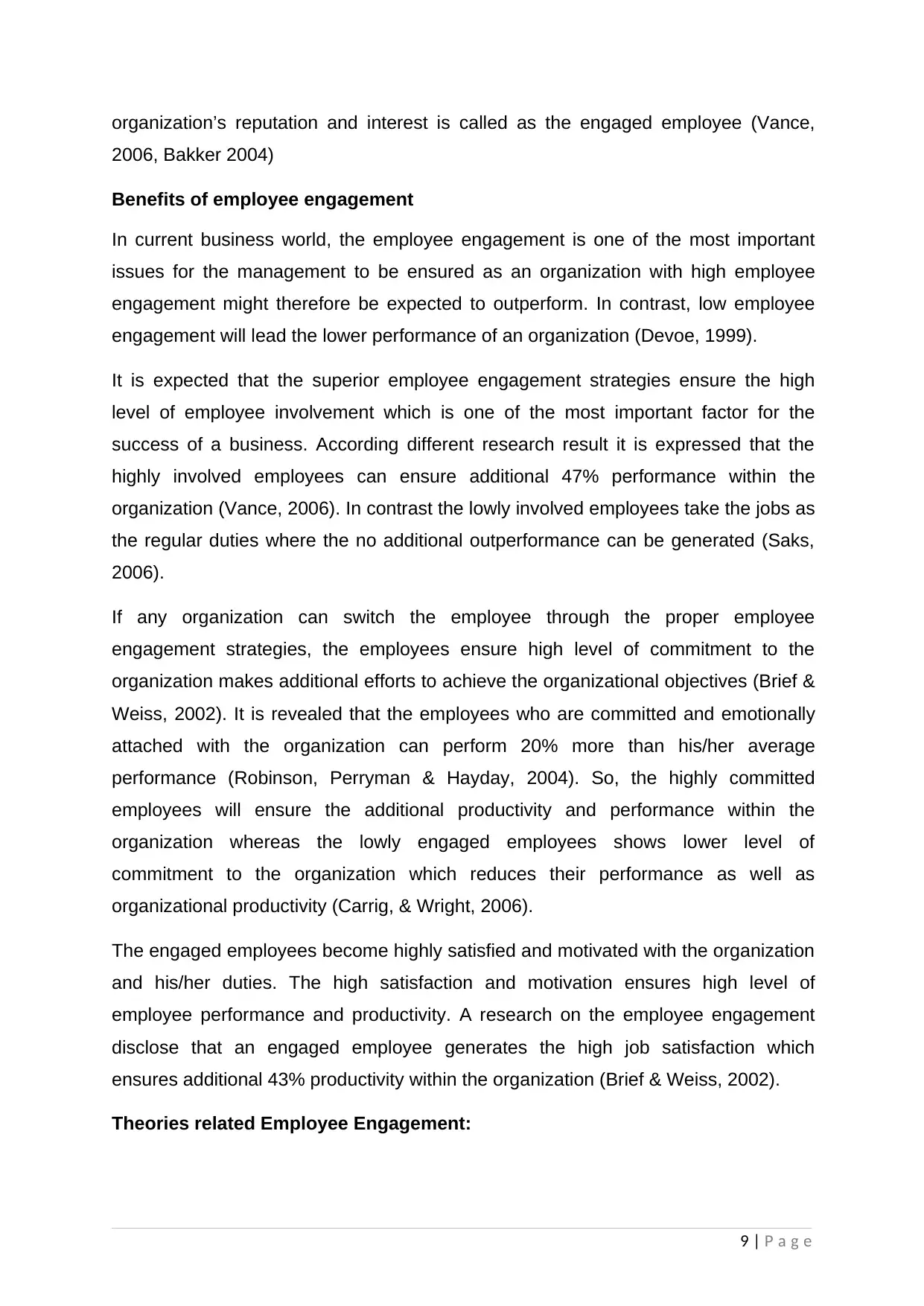
organization’s reputation and interest is called as the engaged employee (Vance,
2006, Bakker 2004)
Benefits of employee engagement
In current business world, the employee engagement is one of the most important
issues for the management to be ensured as an organization with high employee
engagement might therefore be expected to outperform. In contrast, low employee
engagement will lead the lower performance of an organization (Devoe, 1999).
It is expected that the superior employee engagement strategies ensure the high
level of employee involvement which is one of the most important factor for the
success of a business. According different research result it is expressed that the
highly involved employees can ensure additional 47% performance within the
organization (Vance, 2006). In contrast the lowly involved employees take the jobs as
the regular duties where the no additional outperformance can be generated (Saks,
2006).
If any organization can switch the employee through the proper employee
engagement strategies, the employees ensure high level of commitment to the
organization makes additional efforts to achieve the organizational objectives (Brief &
Weiss, 2002). It is revealed that the employees who are committed and emotionally
attached with the organization can perform 20% more than his/her average
performance (Robinson, Perryman & Hayday, 2004). So, the highly committed
employees will ensure the additional productivity and performance within the
organization whereas the lowly engaged employees shows lower level of
commitment to the organization which reduces their performance as well as
organizational productivity (Carrig, & Wright, 2006).
The engaged employees become highly satisfied and motivated with the organization
and his/her duties. The high satisfaction and motivation ensures high level of
employee performance and productivity. A research on the employee engagement
disclose that an engaged employee generates the high job satisfaction which
ensures additional 43% productivity within the organization (Brief & Weiss, 2002).
Theories related Employee Engagement:
9 | P a g e
2006, Bakker 2004)
Benefits of employee engagement
In current business world, the employee engagement is one of the most important
issues for the management to be ensured as an organization with high employee
engagement might therefore be expected to outperform. In contrast, low employee
engagement will lead the lower performance of an organization (Devoe, 1999).
It is expected that the superior employee engagement strategies ensure the high
level of employee involvement which is one of the most important factor for the
success of a business. According different research result it is expressed that the
highly involved employees can ensure additional 47% performance within the
organization (Vance, 2006). In contrast the lowly involved employees take the jobs as
the regular duties where the no additional outperformance can be generated (Saks,
2006).
If any organization can switch the employee through the proper employee
engagement strategies, the employees ensure high level of commitment to the
organization makes additional efforts to achieve the organizational objectives (Brief &
Weiss, 2002). It is revealed that the employees who are committed and emotionally
attached with the organization can perform 20% more than his/her average
performance (Robinson, Perryman & Hayday, 2004). So, the highly committed
employees will ensure the additional productivity and performance within the
organization whereas the lowly engaged employees shows lower level of
commitment to the organization which reduces their performance as well as
organizational productivity (Carrig, & Wright, 2006).
The engaged employees become highly satisfied and motivated with the organization
and his/her duties. The high satisfaction and motivation ensures high level of
employee performance and productivity. A research on the employee engagement
disclose that an engaged employee generates the high job satisfaction which
ensures additional 43% productivity within the organization (Brief & Weiss, 2002).
Theories related Employee Engagement:
9 | P a g e
⊘ This is a preview!⊘
Do you want full access?
Subscribe today to unlock all pages.

Trusted by 1+ million students worldwide
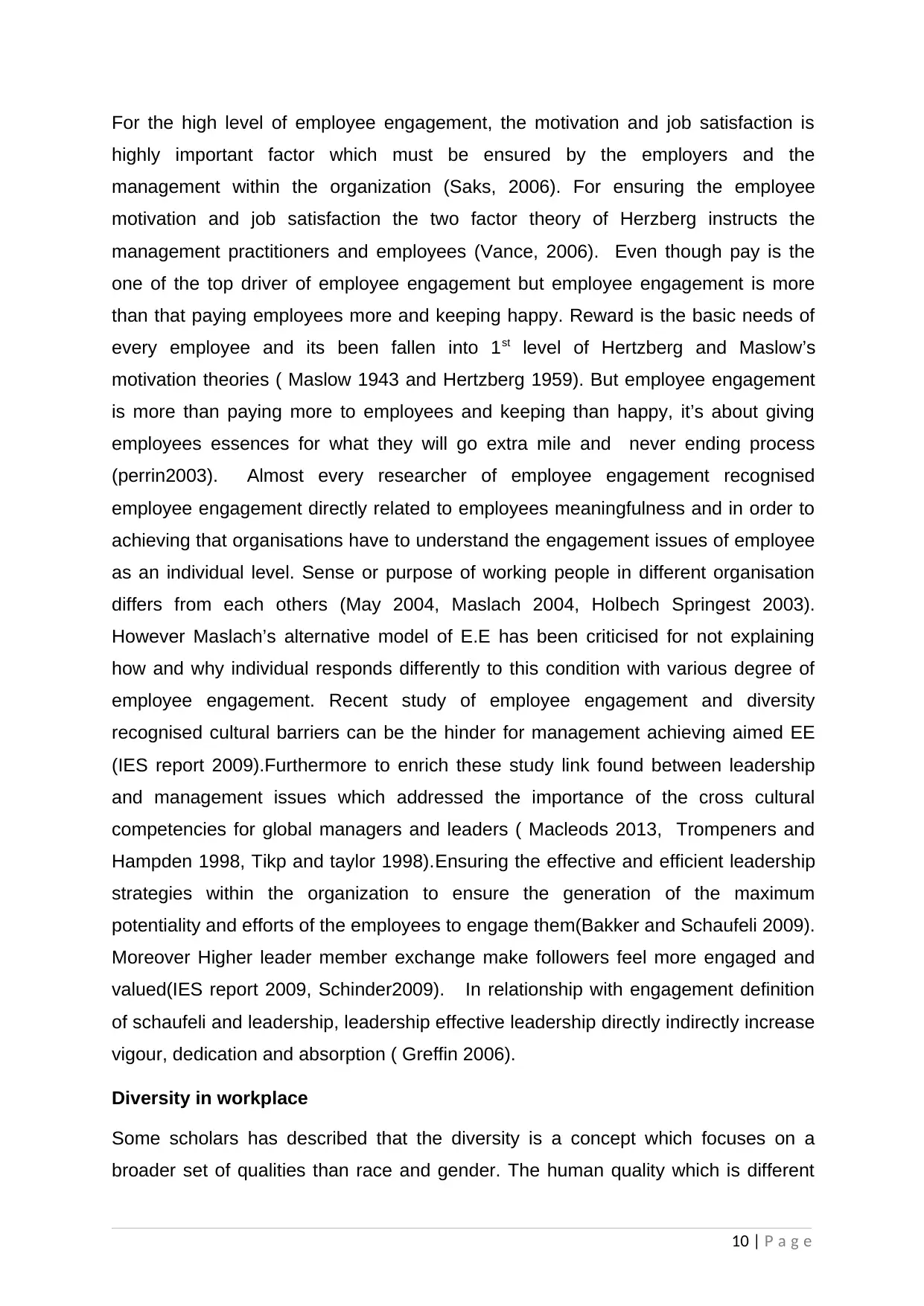
For the high level of employee engagement, the motivation and job satisfaction is
highly important factor which must be ensured by the employers and the
management within the organization (Saks, 2006). For ensuring the employee
motivation and job satisfaction the two factor theory of Herzberg instructs the
management practitioners and employees (Vance, 2006). Even though pay is the
one of the top driver of employee engagement but employee engagement is more
than that paying employees more and keeping happy. Reward is the basic needs of
every employee and its been fallen into 1st level of Hertzberg and Maslow’s
motivation theories ( Maslow 1943 and Hertzberg 1959). But employee engagement
is more than paying more to employees and keeping than happy, it’s about giving
employees essences for what they will go extra mile and never ending process
(perrin2003). Almost every researcher of employee engagement recognised
employee engagement directly related to employees meaningfulness and in order to
achieving that organisations have to understand the engagement issues of employee
as an individual level. Sense or purpose of working people in different organisation
differs from each others (May 2004, Maslach 2004, Holbech Springest 2003).
However Maslach’s alternative model of E.E has been criticised for not explaining
how and why individual responds differently to this condition with various degree of
employee engagement. Recent study of employee engagement and diversity
recognised cultural barriers can be the hinder for management achieving aimed EE
(IES report 2009).Furthermore to enrich these study link found between leadership
and management issues which addressed the importance of the cross cultural
competencies for global managers and leaders ( Macleods 2013, Trompeners and
Hampden 1998, Tikp and taylor 1998).Ensuring the effective and efficient leadership
strategies within the organization to ensure the generation of the maximum
potentiality and efforts of the employees to engage them(Bakker and Schaufeli 2009).
Moreover Higher leader member exchange make followers feel more engaged and
valued(IES report 2009, Schinder2009). In relationship with engagement definition
of schaufeli and leadership, leadership effective leadership directly indirectly increase
vigour, dedication and absorption ( Greffin 2006).
Diversity in workplace
Some scholars has described that the diversity is a concept which focuses on a
broader set of qualities than race and gender. The human quality which is different
10 | P a g e
highly important factor which must be ensured by the employers and the
management within the organization (Saks, 2006). For ensuring the employee
motivation and job satisfaction the two factor theory of Herzberg instructs the
management practitioners and employees (Vance, 2006). Even though pay is the
one of the top driver of employee engagement but employee engagement is more
than that paying employees more and keeping happy. Reward is the basic needs of
every employee and its been fallen into 1st level of Hertzberg and Maslow’s
motivation theories ( Maslow 1943 and Hertzberg 1959). But employee engagement
is more than paying more to employees and keeping than happy, it’s about giving
employees essences for what they will go extra mile and never ending process
(perrin2003). Almost every researcher of employee engagement recognised
employee engagement directly related to employees meaningfulness and in order to
achieving that organisations have to understand the engagement issues of employee
as an individual level. Sense or purpose of working people in different organisation
differs from each others (May 2004, Maslach 2004, Holbech Springest 2003).
However Maslach’s alternative model of E.E has been criticised for not explaining
how and why individual responds differently to this condition with various degree of
employee engagement. Recent study of employee engagement and diversity
recognised cultural barriers can be the hinder for management achieving aimed EE
(IES report 2009).Furthermore to enrich these study link found between leadership
and management issues which addressed the importance of the cross cultural
competencies for global managers and leaders ( Macleods 2013, Trompeners and
Hampden 1998, Tikp and taylor 1998).Ensuring the effective and efficient leadership
strategies within the organization to ensure the generation of the maximum
potentiality and efforts of the employees to engage them(Bakker and Schaufeli 2009).
Moreover Higher leader member exchange make followers feel more engaged and
valued(IES report 2009, Schinder2009). In relationship with engagement definition
of schaufeli and leadership, leadership effective leadership directly indirectly increase
vigour, dedication and absorption ( Greffin 2006).
Diversity in workplace
Some scholars has described that the diversity is a concept which focuses on a
broader set of qualities than race and gender. The human quality which is different
10 | P a g e
Paraphrase This Document
Need a fresh take? Get an instant paraphrase of this document with our AI Paraphraser
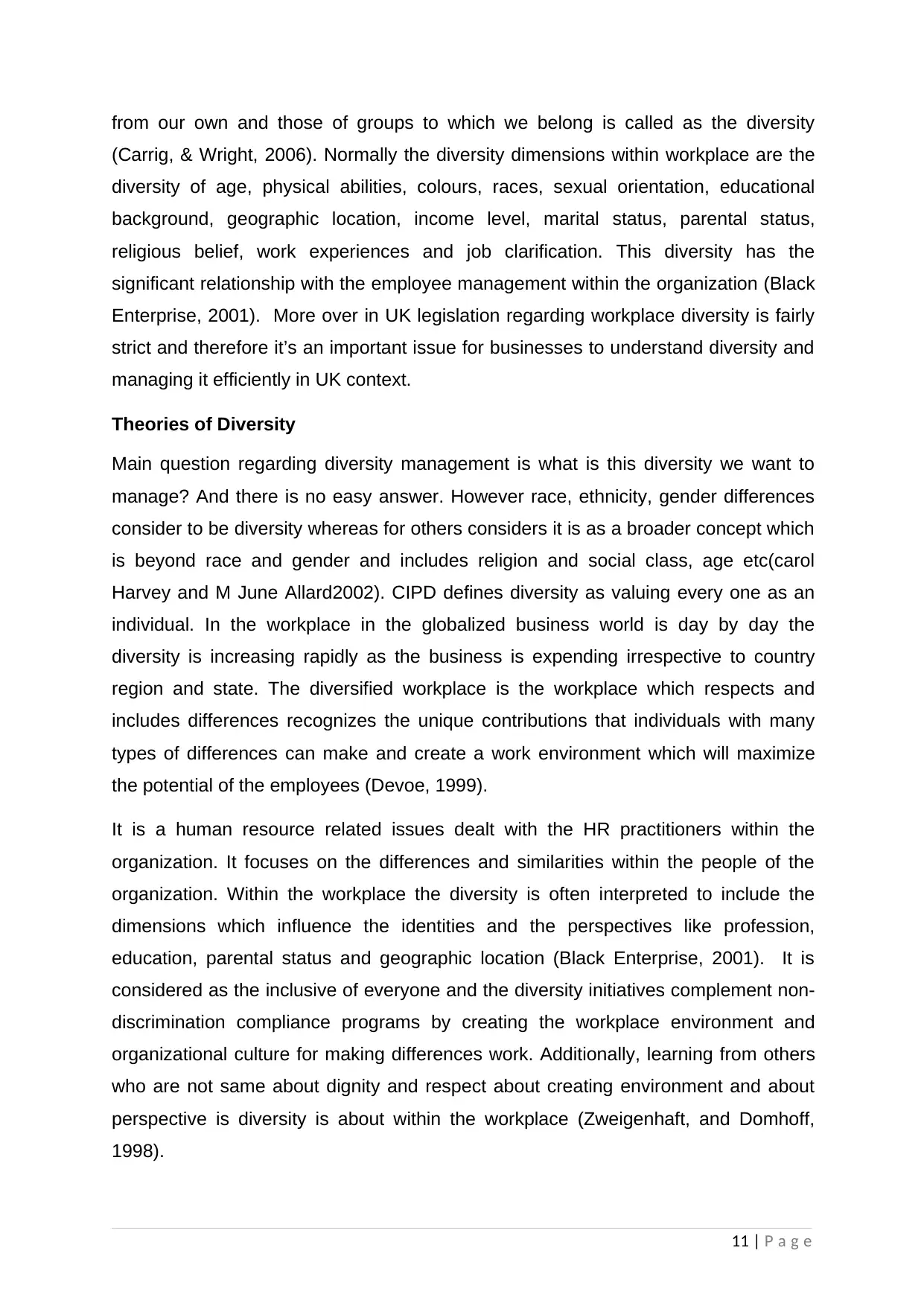
from our own and those of groups to which we belong is called as the diversity
(Carrig, & Wright, 2006). Normally the diversity dimensions within workplace are the
diversity of age, physical abilities, colours, races, sexual orientation, educational
background, geographic location, income level, marital status, parental status,
religious belief, work experiences and job clarification. This diversity has the
significant relationship with the employee management within the organization (Black
Enterprise, 2001). More over in UK legislation regarding workplace diversity is fairly
strict and therefore it’s an important issue for businesses to understand diversity and
managing it efficiently in UK context.
Theories of Diversity
Main question regarding diversity management is what is this diversity we want to
manage? And there is no easy answer. However race, ethnicity, gender differences
consider to be diversity whereas for others considers it is as a broader concept which
is beyond race and gender and includes religion and social class, age etc(carol
Harvey and M June Allard2002). CIPD defines diversity as valuing every one as an
individual. In the workplace in the globalized business world is day by day the
diversity is increasing rapidly as the business is expending irrespective to country
region and state. The diversified workplace is the workplace which respects and
includes differences recognizes the unique contributions that individuals with many
types of differences can make and create a work environment which will maximize
the potential of the employees (Devoe, 1999).
It is a human resource related issues dealt with the HR practitioners within the
organization. It focuses on the differences and similarities within the people of the
organization. Within the workplace the diversity is often interpreted to include the
dimensions which influence the identities and the perspectives like profession,
education, parental status and geographic location (Black Enterprise, 2001). It is
considered as the inclusive of everyone and the diversity initiatives complement non-
discrimination compliance programs by creating the workplace environment and
organizational culture for making differences work. Additionally, learning from others
who are not same about dignity and respect about creating environment and about
perspective is diversity is about within the workplace (Zweigenhaft, and Domhoff,
1998).
11 | P a g e
(Carrig, & Wright, 2006). Normally the diversity dimensions within workplace are the
diversity of age, physical abilities, colours, races, sexual orientation, educational
background, geographic location, income level, marital status, parental status,
religious belief, work experiences and job clarification. This diversity has the
significant relationship with the employee management within the organization (Black
Enterprise, 2001). More over in UK legislation regarding workplace diversity is fairly
strict and therefore it’s an important issue for businesses to understand diversity and
managing it efficiently in UK context.
Theories of Diversity
Main question regarding diversity management is what is this diversity we want to
manage? And there is no easy answer. However race, ethnicity, gender differences
consider to be diversity whereas for others considers it is as a broader concept which
is beyond race and gender and includes religion and social class, age etc(carol
Harvey and M June Allard2002). CIPD defines diversity as valuing every one as an
individual. In the workplace in the globalized business world is day by day the
diversity is increasing rapidly as the business is expending irrespective to country
region and state. The diversified workplace is the workplace which respects and
includes differences recognizes the unique contributions that individuals with many
types of differences can make and create a work environment which will maximize
the potential of the employees (Devoe, 1999).
It is a human resource related issues dealt with the HR practitioners within the
organization. It focuses on the differences and similarities within the people of the
organization. Within the workplace the diversity is often interpreted to include the
dimensions which influence the identities and the perspectives like profession,
education, parental status and geographic location (Black Enterprise, 2001). It is
considered as the inclusive of everyone and the diversity initiatives complement non-
discrimination compliance programs by creating the workplace environment and
organizational culture for making differences work. Additionally, learning from others
who are not same about dignity and respect about creating environment and about
perspective is diversity is about within the workplace (Zweigenhaft, and Domhoff,
1998).
11 | P a g e
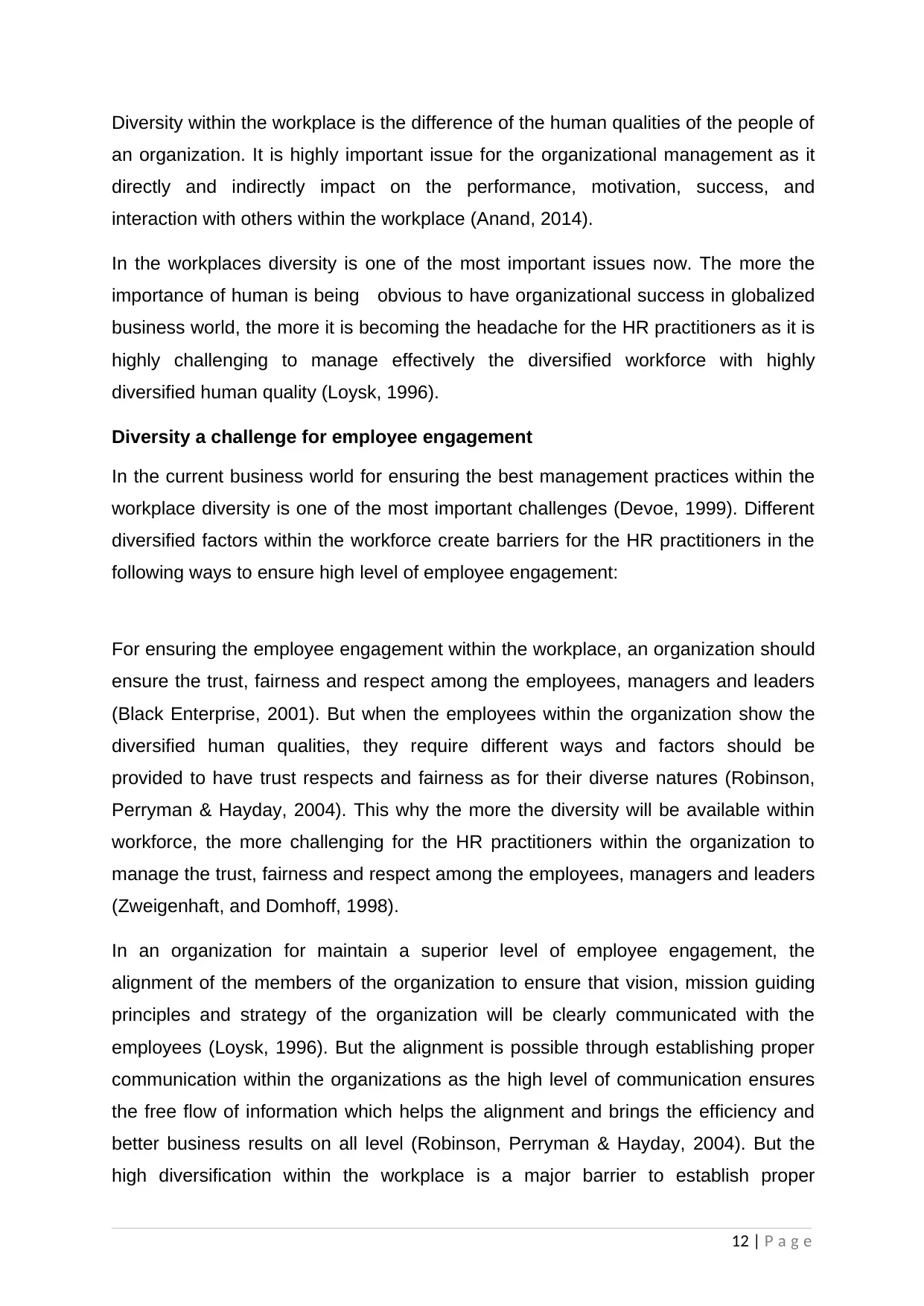
Diversity within the workplace is the difference of the human qualities of the people of
an organization. It is highly important issue for the organizational management as it
directly and indirectly impact on the performance, motivation, success, and
interaction with others within the workplace (Anand, 2014).
In the workplaces diversity is one of the most important issues now. The more the
importance of human is being obvious to have organizational success in globalized
business world, the more it is becoming the headache for the HR practitioners as it is
highly challenging to manage effectively the diversified workforce with highly
diversified human quality (Loysk, 1996).
Diversity a challenge for employee engagement
In the current business world for ensuring the best management practices within the
workplace diversity is one of the most important challenges (Devoe, 1999). Different
diversified factors within the workforce create barriers for the HR practitioners in the
following ways to ensure high level of employee engagement:
For ensuring the employee engagement within the workplace, an organization should
ensure the trust, fairness and respect among the employees, managers and leaders
(Black Enterprise, 2001). But when the employees within the organization show the
diversified human qualities, they require different ways and factors should be
provided to have trust respects and fairness as for their diverse natures (Robinson,
Perryman & Hayday, 2004). This why the more the diversity will be available within
workforce, the more challenging for the HR practitioners within the organization to
manage the trust, fairness and respect among the employees, managers and leaders
(Zweigenhaft, and Domhoff, 1998).
In an organization for maintain a superior level of employee engagement, the
alignment of the members of the organization to ensure that vision, mission guiding
principles and strategy of the organization will be clearly communicated with the
employees (Loysk, 1996). But the alignment is possible through establishing proper
communication within the organizations as the high level of communication ensures
the free flow of information which helps the alignment and brings the efficiency and
better business results on all level (Robinson, Perryman & Hayday, 2004). But the
high diversification within the workplace is a major barrier to establish proper
12 | P a g e
an organization. It is highly important issue for the organizational management as it
directly and indirectly impact on the performance, motivation, success, and
interaction with others within the workplace (Anand, 2014).
In the workplaces diversity is one of the most important issues now. The more the
importance of human is being obvious to have organizational success in globalized
business world, the more it is becoming the headache for the HR practitioners as it is
highly challenging to manage effectively the diversified workforce with highly
diversified human quality (Loysk, 1996).
Diversity a challenge for employee engagement
In the current business world for ensuring the best management practices within the
workplace diversity is one of the most important challenges (Devoe, 1999). Different
diversified factors within the workforce create barriers for the HR practitioners in the
following ways to ensure high level of employee engagement:
For ensuring the employee engagement within the workplace, an organization should
ensure the trust, fairness and respect among the employees, managers and leaders
(Black Enterprise, 2001). But when the employees within the organization show the
diversified human qualities, they require different ways and factors should be
provided to have trust respects and fairness as for their diverse natures (Robinson,
Perryman & Hayday, 2004). This why the more the diversity will be available within
workforce, the more challenging for the HR practitioners within the organization to
manage the trust, fairness and respect among the employees, managers and leaders
(Zweigenhaft, and Domhoff, 1998).
In an organization for maintain a superior level of employee engagement, the
alignment of the members of the organization to ensure that vision, mission guiding
principles and strategy of the organization will be clearly communicated with the
employees (Loysk, 1996). But the alignment is possible through establishing proper
communication within the organizations as the high level of communication ensures
the free flow of information which helps the alignment and brings the efficiency and
better business results on all level (Robinson, Perryman & Hayday, 2004). But the
high diversification within the workplace is a major barrier to establish proper
12 | P a g e
⊘ This is a preview!⊘
Do you want full access?
Subscribe today to unlock all pages.

Trusted by 1+ million students worldwide
1 out of 40
Related Documents
Your All-in-One AI-Powered Toolkit for Academic Success.
+13062052269
info@desklib.com
Available 24*7 on WhatsApp / Email
![[object Object]](/_next/static/media/star-bottom.7253800d.svg)
Unlock your academic potential
Copyright © 2020–2025 A2Z Services. All Rights Reserved. Developed and managed by ZUCOL.





